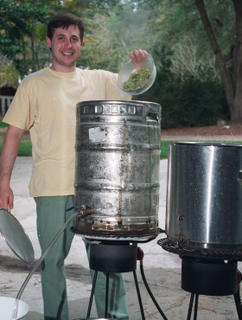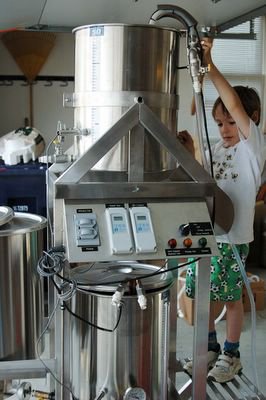Thursday, June 18, 2009
It appears that we have the old style tanks that do not have the saftey protection valve (or whatever) that is now required of all tanks. Bottom line, they cannot be filled. They are worth the gas inside them, and we will give them away for FREE. If nobody steps up, I will take them to HMI Welding Supply and Propane Gas in Christiansburg so that those folks can do whatever it is that is done to tanks like ours. It is a sad day to say goodbye to tanks that helped us brew some good beer. But such is life. Drink up and enjoy it while we can! Cheers to all good LP tanks and all good beers!
LP Tanks that Need a New Home



Here are some pictures of the LP tanks, including a general picture (with ruler for scale) as well as a few closeups. Let me know if you have questions. If you post a comment, then an email will be sent to my email address. Or if you know how to reach me directly, feel free to send a note directly to me. Thanks.
Monday, November 07, 2005
Brewing Day, Part 1
Our new brewing system has three kettles, one for each specific purpose: 1) MASH, 2)SPARGE, 3) BOIL. See PHOTOS BELOW... The MASH is located at the very top, directly above the SPARGE, and the BOIL is off to one side. I will include several photographs from our first brewing day, as well as a brief description of what we did.
Once everything was CLEAN and ready to go and all the ingredients were weighed/measured and ready, one of the first steps was to add water (which we passed through an in-line filter) to the MASH kettle. We heated this water to 168 oF before adding the grains for mashing (the process of soaking the grains so that the starches are converted to sugars.
The SPARGE water, below the mash, was also heated to 168 oF so that it could be used to run through the grain bed and help convert and extract the sugars. The hot SPARGE kettle helped keep the MASH kettle at the correct temperature. Water was pumped up from the SPARGE to the MASH through a rubber tube and then dispersed into the grain bed by a circular copper tube with holes. The last picture in this section shows a closeup of the sparge bed. If you look carefully, you can see the circular copper tube.
After about 90 min of mashing, the liquid (called wort) was ready for the boil. The liquid was drained off through an opening at the bottom of the MASH kettle and into the BOIL kettle. During the boil, various amounts of hops were added at different times... I will elaborate on this another time. I will try to explain the process more fully when we brew another batch, but this time around, I was also busy cleaning the garage, and not taking notes on such things as which ingredients were used and how much.
I will also talk about the fermentation process in a quick overview for this batch and in more detail when we get to another batch. I would like to do a more thorough job on this part of the website, but I have to remember that WOODLANDS SPRING (see link on the right) is my higher priority.
Once everything was CLEAN and ready to go and all the ingredients were weighed/measured and ready, one of the first steps was to add water (which we passed through an in-line filter) to the MASH kettle. We heated this water to 168 oF before adding the grains for mashing (the process of soaking the grains so that the starches are converted to sugars.
The SPARGE water, below the mash, was also heated to 168 oF so that it could be used to run through the grain bed and help convert and extract the sugars. The hot SPARGE kettle helped keep the MASH kettle at the correct temperature. Water was pumped up from the SPARGE to the MASH through a rubber tube and then dispersed into the grain bed by a circular copper tube with holes. The last picture in this section shows a closeup of the sparge bed. If you look carefully, you can see the circular copper tube.
After about 90 min of mashing, the liquid (called wort) was ready for the boil. The liquid was drained off through an opening at the bottom of the MASH kettle and into the BOIL kettle. During the boil, various amounts of hops were added at different times... I will elaborate on this another time. I will try to explain the process more fully when we brew another batch, but this time around, I was also busy cleaning the garage, and not taking notes on such things as which ingredients were used and how much.
I will also talk about the fermentation process in a quick overview for this batch and in more detail when we get to another batch. I would like to do a more thorough job on this part of the website, but I have to remember that WOODLANDS SPRING (see link on the right) is my higher priority.
The Malt
While the water was being heated to 168 oF, Ed crushed the grain using this malt mill. Instead of turning the crank by hand, he hooked up a drill. Once the water reaches the correct temperature, the grain will be added to the water for about 60 to 90 minutes, while starches are converted to sugars.
The kettle below the MASH is the SPARGE kettle, which we also heated to 168 oF. The SPARGE water is kept at the correct temperature and pumped into the MASH, and the hot water is sprinked over the grains. There is a pump to circulate the water from the sparge kettle into the mash, but also the heat of the sparge kettle will rise to the mash kettle, thus helping keep the mash warm.
The kettle below the MASH is the SPARGE kettle, which we also heated to 168 oF. The SPARGE water is kept at the correct temperature and pumped into the MASH, and the hot water is sprinked over the grains. There is a pump to circulate the water from the sparge kettle into the mash, but also the heat of the sparge kettle will rise to the mash kettle, thus helping keep the mash warm.
Saturday, November 05, 2005
Dry Stout
Today we brewed a DRY STOUT. I got lots of photos while Ed (my husband) did most of the work. I plan to post some photos within the next couple days. Sorry about the delay, but I am pretty worn out due to the fact that I was also trying to clean out the garage. I am happy to say that I pretty much finished the job, but now I am too tired to even get the images off the camera to check them out.
Tuesday, October 04, 2005
What's Brewing?
Welcome to my new website called, "What's Brewing." This may get off to a slow start because it has been a few years since we have done brewing, but I will surely have lots to say once things get up and running. First of all, Ed and I have been brewing beer together since we first met back in Iowa in the early 1990s. It started with extract and some grains, but eventually we switched to all grain. We were members of the homebrew club called THIRSTY in Iowa City, and met a lot of good brewers in those days. In fact, our wedding was a "pot luck" event at a local state forest, and most of our guests were members of the homebrew club.
Also, back in the 1990s, we became beer judges, as part of the Beer Judge Certification Program (BJCP) affiliated with the American Homebrewer's Association (AHA).
We moved a few times since Iowa, including a few years in Florida, where we were pretty active with the homebrew club down there, and then to Michigan, where we mostly did brewing on our own. Well now we have moved "out east," have unpacked our equipment, upgraded a few things, and figured out how to set up the brewery--for the most part.
Soon we will be brewing again, soI thought it would be fun to report on our progress through this website. As with my wildflower website called WOODLAND SPRING, I plan to combine photographs and "story telling" to explain such things as the process of making beer, and descriptions of the various styles of beer. As with WOODLAND SPRING, I will avoid technical jargon, for the most part. I want this website to be informative, but also fun.
So stay tuned for the next update... I may post some old pictures one of these days, and it will not be long before I start posting some current pictures too!
Also, back in the 1990s, we became beer judges, as part of the Beer Judge Certification Program (BJCP) affiliated with the American Homebrewer's Association (AHA).
We moved a few times since Iowa, including a few years in Florida, where we were pretty active with the homebrew club down there, and then to Michigan, where we mostly did brewing on our own. Well now we have moved "out east," have unpacked our equipment, upgraded a few things, and figured out how to set up the brewery--for the most part.
Soon we will be brewing again, soI thought it would be fun to report on our progress through this website. As with my wildflower website called WOODLAND SPRING, I plan to combine photographs and "story telling" to explain such things as the process of making beer, and descriptions of the various styles of beer. As with WOODLAND SPRING, I will avoid technical jargon, for the most part. I want this website to be informative, but also fun.
So stay tuned for the next update... I may post some old pictures one of these days, and it will not be long before I start posting some current pictures too!
Monday, October 03, 2005
Ed Adds Hops

Here is a photograph of Ed getting ready to add hops to the boil. Over the next several months, I plan to add more informative details about such things as these: 1) Why add hops? 2) When add hops? 3) What type of hops? etc. This is just the tip of an iceberg, and it will take a while to do a good job.







